Hardened drops of grease, sticky deposits, dirt spots, mold on the seams of tiles are unaesthetic and unhealthy things. Sadly, the occurrence of greasy and dirty stains on the kitchen apron cannot be prevented or avoided. The best option is to wipe the work surfaces every time after cooking, immediately removing splashes of grease and traces of dirt. But even if the hostesses do not have the opportunity to clean the kitchen all day or after every dinner, there are many simple ways to clean the tiles in the kitchen from grease after a while.
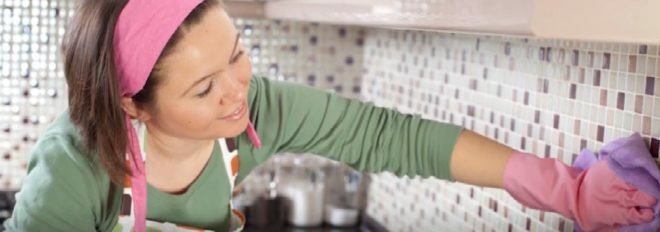
Image taken from https://www.youtube.com/watch? v = DIICp8MwjqY
General tips for tile maintenance
An important advantage of the tile in comparison with other materials used for finishing the apron is the speed and ease of maintenance, provided that it is cleaned on time. Ceramic tiles will sparkle with cleanliness if splashes are immediately removed from them, and the drops of grease have not had time to harden. However, even stubborn dirt can be eliminated using both expensive and budget options: improvised materials, folk recipes, products of the chemical industry.
Thinking about the question: - "How to wash the tiles in the kitchen from fat?", Many housewives give preference to the means that are always present in the house. To clean surfaces, soap solution is most often used - an inexpensive, quickly and easily manufactured composition. To prepare the detergent, 10 g of laundry soap (a small remnant) is rubbed on a coarse grater and poured with a liter of warm water. Mix thoroughly and apply to the surface with a soft sponge. Leave to act for 5 minutes. Then they are thoroughly washed off first with warm, then cold water. The tiles are rubbed to a shine with a dry microfiber cloth - a material that does not leave stains and streaks.
Attention! Earned on our website kitchen designer. You can familiarize yourself with it and design your dream kitchen for free! May also come in handy wardrobes designer.
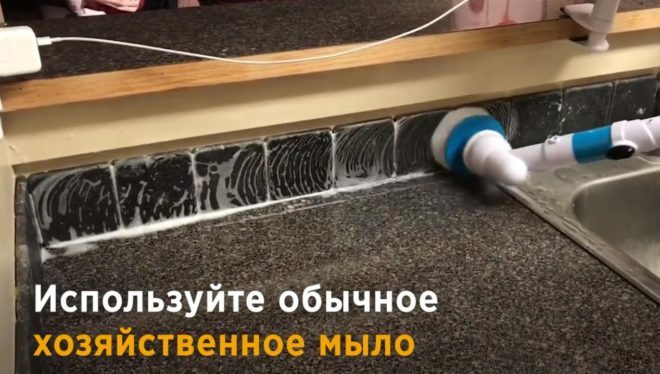
Image taken from https://www.youtube.com/watch? v = DIICp8MwjqY
Stubborn dirt and grease will require more effort to remove them. The applied soap solution is left on the tiled surface for 15 minutes. To remove frozen drops of fat, it is advisable to purchase a special tile scraper. Made of rubber and plastic, this product is ideal for smooth surfaces, making cleaning quick and easy.
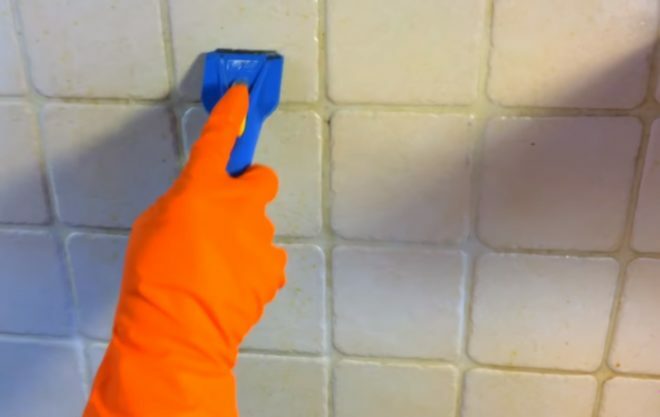
Image taken from https://www.youtube.com/watch? v = fiaohMygsmo
Household chemicals against fat - the best remedies
You can effortlessly remove stubborn dirt, mold and grease by using household chemicals. For a quick effect, you should use products from trusted manufacturers designed specifically for these purposes. Before you clean the tiles from grease in the kitchen, you should carefully read the instructions on the package.
It is important to follow all of the precautions listed. It is necessary to carry out cleaning in special thick rubber gloves, tightly fitting the brush. When using aggressive compounds, it is necessary to take care of the health of the respiratory system by wearing a medical mask and arranging intensive ventilation of the premises. If funds come into contact with the skin or mucous membranes, rinse the affected area with copious amounts of cool water. All food and liquids should be removed from the kitchen counter before cleaning.
The range of household chemicals that break down dirt accumulations, dissolve fats and destroy mold is huge. It is presented in a different price range. The most popular and proven brands include:
- HG;
- Mellerud;
- Mr Muscle;
- Bagi "Shumanite";
- Sanit;
- Cillit Bang.
Compositions for cleaning tiles are presented in different forms: in the form of powders, gels, spray agents. They may be labeled “Anti-grease” or “for ceramic surfaces”. However, professional cleaning companies do not recommend the use of abrasive cleaning powders. These products often leave scratches on ceramic products.

Image taken from https://www.youtube.com/watch? v = GykLJlxCrBg
Folk remedies for fat
Housewives who prefer natural cleaning methods can be advised to wash the tiles in the kitchen from fat using folk remedies. The advantages of these cleaning options:
- economic affordability;
- ease of preparation of compositions;
- no health risk.
Baking soda
An easy and harmless method of cleaning ceramic surfaces is the use of sodium bicarbonate. Baking soda is a proven disinfectant available at most retail outlets at low cost. Work surfaces are cleaned with a slightly moistened soft cloth with dry baking soda powder. The exposure time is from 5 minutes. Then wash off with warm water using a soft sponge.
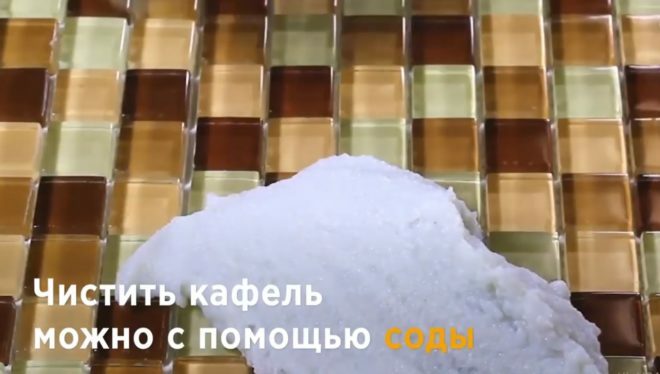
Image taken from https://www.youtube.com/watch? v = DIICp8MwjqY
Soda and water
Another way to remove grease from tiles in the kitchen is to spray the tiles with water from a spray bottle. A small amount of sodium bicarbonate should be applied to a damp surface and left to act for 15-20 minutes. Then, with light movements, walk over the surface with a kitchen sponge. Wash off the rest of the composition with cold water. Rub the ceramic tiles with a dry microfiber cloth until they shine.
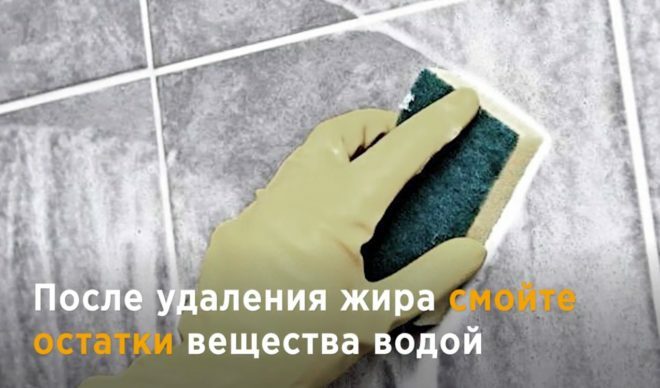
Image taken from https://www.youtube.com/watch? v = DIICp8MwjqY
Soda and vinegar
To remove stale fat and plaque, cover the contaminated area with baking soda gruel. Using a spray bottle, a 9% aqueous solution of food grade acetic acid is sprayed from above. After 5 minutes, the composition is washed off.
Stubborn stains on tiles (from coffee, fruit, wine) can be removed with the following composition. The same amount of vinegar is added to a tablespoon of baking soda. The mixture is quickly applied to the treated area and left to act for 10 minutes. Then rub with a hard sponge and rinse off with water.
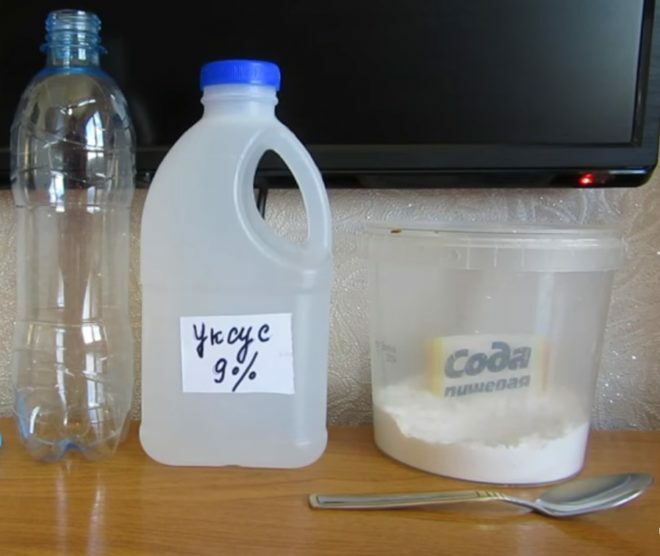
Image taken from https://www.youtube.com/watch? v = C8vfcxJGIFA
Soda and vegetable oil
This is a surface-friendly composition, but its use has a less pronounced effect. Therefore, most housewives use vegetable oil only when there is no vinegar on hand. In addition, additional time is required to clean the surfaces. After applying such a composition, the tiles will need to be treated with degreasing agents.
Pour 5 tbsp into 200 ml of sunflower oil. l. soda and stir thoroughly. Using a sponge, apply the mixture to the area to be treated. The exposure period is from 45 to 60 minutes. Then the composition should be completely removed.
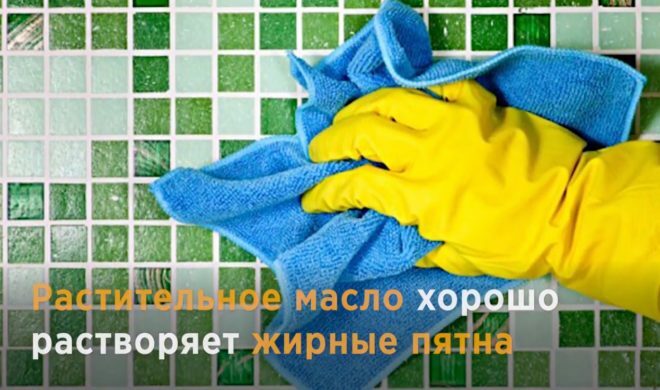
Image taken from https://www.youtube.com/watch? v = DIICp8MwjqY
Soda with citric acid and starch
You can remove grease from tiles in the kitchen using a tried and tested recipe. Combine baking soda, potato starch, and citric acid in equal proportions. Slowly pour in slightly warmed water in volume so that the mixture is in consistency like thick sour cream. To remove grease from the tiles, apply the compound to the surface. After a while, the drops of fat will collect into lumps, which should be removed with a wet sponge.
Vinegar
Acetic acid is a folk composition that has been tested for millennia. Vinegar was used in ancient Babylon as a disinfectant (antiseptic) in everyday life.
Vinegar is a component of many combination formulations. Also, for the purpose of disinfection and cleaning, you can wipe the work surfaces with table vinegar diluted in warm water in a ratio of 1: 3. Using this composition, you can achieve a dazzling shine. Along the way, the liquid will eliminate unpleasant odors.
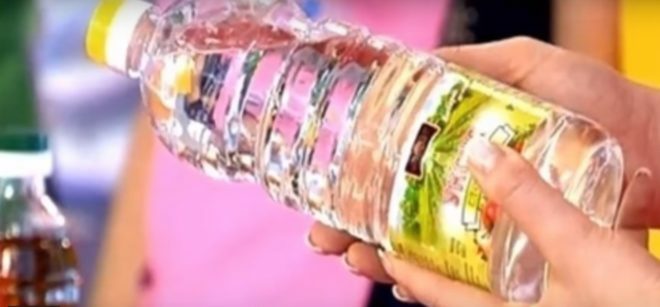
Image taken from https://www.youtube.com/watch? v = wHXbkMHlHO8
Vinegar with ammonia and borax
To prepare the composition, you will need 100 ml of ammonia, 50 g of borax, 100 ml of table vinegar, 5 liters of water heated to 70-80 degrees. Place all components in a glass (plastic) container. Stir the composition thoroughly, use a spray gun to treat the ceramic surfaces. It should be borne in mind: such a mixture acts slowly, therefore, the composition should be removed no earlier than after 30 minutes. After the product has been washed off with clean water, the surface must be polished.
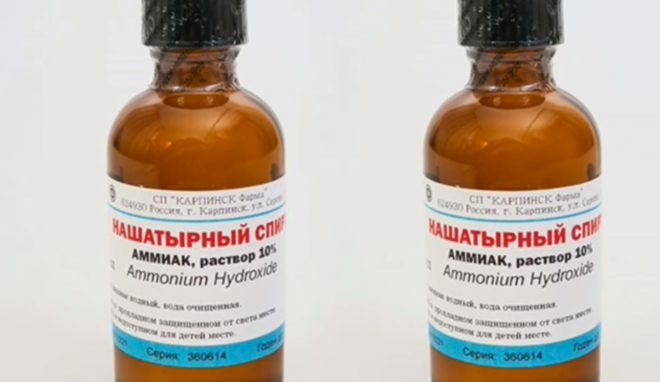
Image taken from https://www.youtube.com/watch? v = _8-uWpy9w7Q
Clay vinegar
By combining these components, you get an excellent mixture for removing dirt, rust, grease. For the best result, it is advisable to purchase cosmetic clay, which does not contain coarse foreign inclusions. Slowly pour 50 ml of warm water into 100 g of powder and stir until smooth. Add 2 tbsp. l. vinegar and quickly apply to the surface. Wash off the gruel immediately after application.
How to clean tiles? Recommendations
Before you clean the tiles from grease in the kitchen, you need to study the general recommendations for caring for this material. This will not only remove unattractive dirt, but will also help maintain the original appearance of the ceramic. Experts advise:
- Do not postpone cleaning the ceramic surface. Carry out light cleaning in a timely manner - after each cooking process.
- Most often it is necessary to use warm detergents. In a heated state, the active ingredients significantly accelerate the rate of removal of greasy stains, but at the same time they have a more noticeable effect on the respiratory system (this is especially true for vinegar and ammonia).
- Regardless of the choice of options, how you can wash the tiles in the kitchen from grease, it is necessary to act on the surface with melamine sponges, napkins, hair brushes. Avoid using metal scrapers, blades and knives. Maximum - a soft stainless steel scraper.
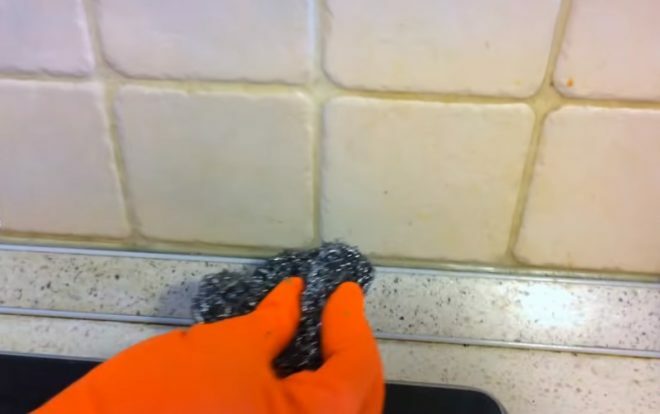
Image taken from https://www.youtube.com/watch? v = fiaohMygsmo
How to wash the tiles from old fat and plaque?
If the cleaning has not been carried out for a long time, it is most advisable to use formulations with the active ingredient - chlorine. Chlorine-containing disinfectants effectively and quickly destroy various harmful microorganisms, allow you to get rid of bacteria, viruses, mold, fungi. When choosing funds, you should pay close attention to the percentage of the active substance content, the form of release, the manufacturer, the shelf life and the storage period.
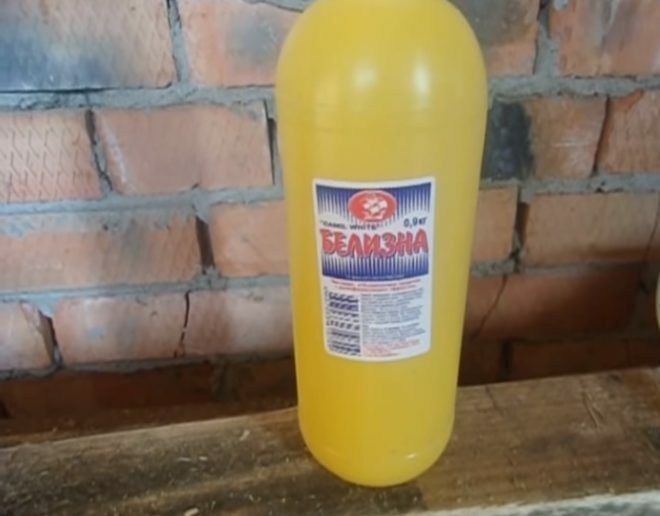
Image taken from https://www.youtube.com/watch? v = jd0mngfnezk
How to clean stains and dirt from tiles?
To eliminate stains from coffee, tea, wine, juice, a recipe that is already very many years old is suitable. Pour 1 liter of water into a glass container and add 30 ml of ammonia. Wipe the ceramic tiles with the resulting liquid. After 15 minutes rinse the surface with clean water.

Image taken from https://www.youtube.com/watch? v = DIICp8MwjqY
Keeping a kitchen in an exemplary state is no easy task. However, the modern arsenal of household chemicals and proven folk remedies greatly facilitates the work of the hostess. The main rule for maintaining a dazzling shine and sterile cleanliness of the tile is the timeliness of cleaning and maintenance.
average rating 0 / 5. Number of ratings: 0
No ratings yet. Be the first to rate.


